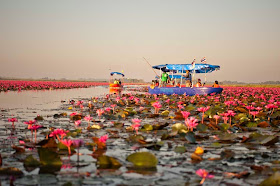 |
| Luang Por Pohm Likit Blessing Duang's Car |
Recently we purchased a Ford Fiesta from our friends. Transferring registration into Duang's name involved the fairly typical tasks of the previous owner paying off the outstanding loan balance, getting Duang's name on the car registration book, and getting Duang's name on the current insurance policy. Last week we went to the Land Transportation Office outside of town and signed some papers as well as paid some nominal fees to register the car in our province. We were told to return tomorrow, Tuesday, to complete the process - inspection and getting new plates .... and pay some additional fee.
There was also another process involved in obtaining the vehicle. We had to get the car properly blessed. The blessing was to be performed before mealtime by Luang Por Pohm Likit out at his temple.
Duang had me drive the car to just outside of Luang Por Pohm Likit's hut. I had to open all the doors as well as the trunk and leave the engine running for the ritual.
Our friend, the Monk, came out of his hut and took a statue of Buddha and a large round glass ball from an ornate metal bowl that he had previously placed on the remnant of a plastic chair. The metal statue of Buddha was an obvious object for a Buddhist ritual blessing but the glass ball has other implications. The ball was like a super sized marble that we used to play "marbles" with, in the time long before smart phones and tablets. Those marbles were highly prized and referred to as "purees". This would have been a very highly prized a long time ago in a far away land.
Many of the believes and rituals here in Isaan are not pure Buddhism but a vestiges of former practices of Animism, Brahminism (precursor to Hinduism), and Hinduism. The glass ball, lukel, is associated with the Naga (serpent ruler of the water underworld). Apparently the glass orb symbolizes the eye of the Naga. Belief in the Naga is very strong today in Lao People's Democratic Republic, Northeast Thailand, and Cambodia.
 |
| Monk Runs Lukel Over Car as He Chants |
 |
| Water Blessing of the Car |
Thailand is the second most dangerous country for driving. I have seen many bad accidents and uncountable number of near accidents in the time that I have stayed here. It is very dangerous and like the wild west out on the roads. Motor vehicles and motorbikes are blessed - I am not sure if the blessings provide any protection, however with as dangerous as the roads are around here it is wise and prudent to take any and all precautions to be safe.
















